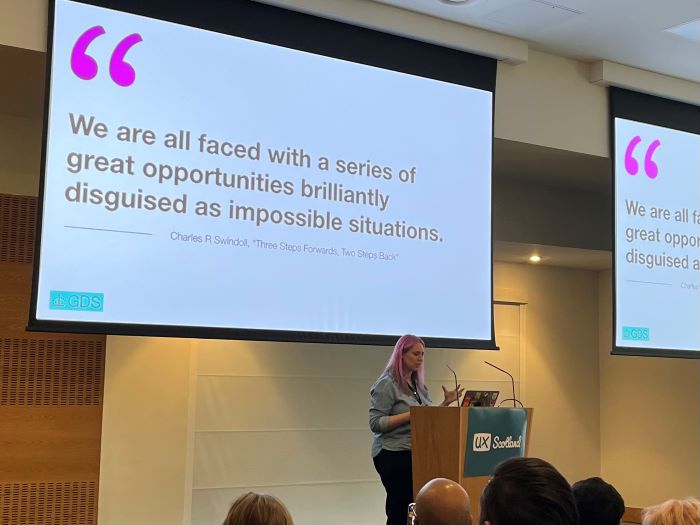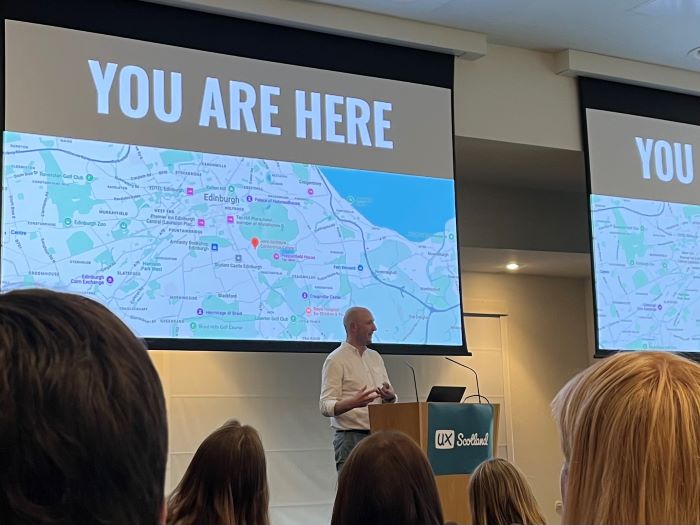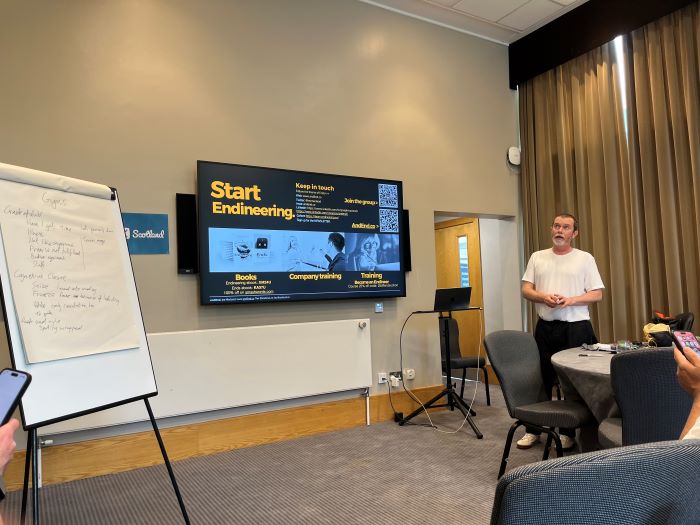Three sessions I attended at UX Scotland 2025
Last month I attended UX Scotland, an annual conference for UX professionals. This post looks at three sessions that stood out to me.
This was my first time attending UX Scotland and I’ve got to say I was really impressed. The whole event was well run and there was a varied set of interesting talks on offer. They’d recruited some big-name keynotes like author Indi Young, and speakers from Californian tech giants like Netflix and Pinterest.
The breakout sessions featured speakers from public sector organisations such as the Government Digital Service, the NHS, and Police Scotland. There were also speakers from consultancies like TPXimpact, who do a fair amount of work within the public sector.
In this post I’m going to write about three sessions that stood out to me.
Serious work, playful minds
Laura Yarrow (Head of Design, Government Digital Service)
Laura’s talk was about how the Government Digital Service (GDS) have been building a culture of creativity. Laura said that people often think of the civil service as the sort of environment that wouldn’t encourage creativity. The rest of the talk was about correcting this misconception and discussing the value of creativity in the work that Laura’s team have done.
The idea that working in the civil service isn’t creative partly comes from the fact that the role of government is to set and enforce rules. Laura accepted that GDS work within constraints to make their digital products accessible and usable, such as the Service Standard. But designers are always working within constraints, and it’s often the constraints that lead to innovation and creativity.
There was an interesting distinction in the presentation, separating invention (creating something entirely new) from innovation (applying existing things in a new way). Laura gave a fun example of innovation where some colleagues in her office had fixed a malfunctioning coat stand with an elastic band.
What contributes to a creative culture
Laura emphasised that a creative culture needs a base layer of psychological safety, with staff feeling able to apply innovative approaches to their work. In addition to this, other important factors for a creative culture are autonomy and opportunities for creative contagion.
One example of creative contagion at GDS is in their community collider events. These are meet-ups for staff that lead to connections, strengthened relationships and staff spotting patterns reoccurring within different teams.
Creativity and AI
This wasn’t primarily an AI talk, but Laura did include a few musings about what AI means for UX designers. She argued that:
- AI is leading us to a generic homogenous plateau;
- our interactions with AI are often a solo activity, at odds with the community activities described earlier in the talk.
She also made the point that we need to keep making things, because making things is how we understand the world. This made me think about AI art. While it’s fun watching computers generate images and write poems, we need to be aware of what we’re losing when we hand over too much of the creative process to them.
I felt like these are all important things to be conscious of as we use AI in the course of our work at the University.

Laura Yarrow presenting at UX Scotland 2025
Everything changes but you: design in the AI era
Ben Holliday (Chief Design Officer, TPXimpact)
Ben’s talk was titled “Everything changes but you”. And yes, the title was inspired by the Take That song.
This was a talk about AI and design, and the main theme was care. Ben talked about the care that goes into good design, and how we’re adept at sensing when that care hasn’t been taken.
Ben took some of the themes covered in Sarah Wynn-Williams’ recent book “Careless People” – an inside story of decision-making inside Facebook – and linked them up with some comments from Jony Ive about how we sense care through the attention given to small details. It made me think of that Marco Pierre-White quote, “Perfection is a lot of little things done well”.
Careless People by Sarah Wynn-Williams (Wikipedia article)
A conversation with Sir Jony Ive KBE
Ben’s talk gave me a lot to chew on. Care is important, and there’s a risk that our increasing use of AI will lead us to a more careless way of living. A letter written entirely by an LLM isn’t going to be written with care, even if it might superficially look like it. That can be applied to various areas of design. Humans need to be involved in the design process somewhere for the care part to exist.
Read the talk as a blog post
Ben has written up his talk as a blog post here:

Ben Holliday presenting at UX Scotland 2025
Endineering
Joe Macleod (Founder, AndEnd)
Thinking about endings
After attending a fair amount of presentations on day one, it was good to mix it up on day two with Joe’s three-hour participatory workshop. Joe talked to us about his main thesis: basically, that organisations pay a lot of attention to beginnings, and very little attention to endings. This simple idea got us started as we discussed how this plays out in practice, why it happens, the consequences it has, and what we can do about it.
The fact that organisations pay scant attention to endings is surprising in some ways, because as humans, endings clearly matter to us. In stories, for example, the ending is really important.
Some work in behavioural economics has also highlighted the impact endings have for us. In Thinking, Fast and Slow, Daniel Kahnemann wrote about the peak-end rule, and how the final part of a medical procedure has a disproportionate influence on our perception of the procedure as a whole.
Looking at phones as an example
When we buy a new phone, all the thought seems to have gone into the beginning. The ads draw us in as new customers, the packaging is carefully made to provide an unboxing experience, and when we first switch the phone on, we’re walked through an onboarding process that imports our apps and contacts.
Joe asked us to contrast that with how our old phones meet their end. When prompted, most of us sheepishly admitted that when our old phones died, we just put them in a drawer. We don’t know what to do with a phone when we move on to a new one. And the companies that build and sell us the phones don’t seem to care that much.
Joe explained that this has environmental consequences: for a lot of products, we don’t know how to get rid of them in a safe and sustainable way. Alongside this, there’s an impact for the companies. The story we tell ourselves about our interaction with a company often has a great beginning and a rubbish ending.

Joe Macleod presenting at UX Scotland.
What we did in the workshop
In the workshop, we did some activities where we analysed how endings work for some example products and services. In one activity we talked about phones, and in another we talked about ending a gym membership. This all helped us to understand the various stages of an ending and where we might be able to suggest improvements.
The topic of the session was relevant to our team’s work at the University with digital content. There’s excitement about new websites, which makes sense when you look at the work it takes to get a new site up and running. And there’s often a some anxiety at the idea of retiring them. The result of this is that we talk more about the process of creating websites than the process of shutting them down. I feel like this is one of the (many) reasons that we have more content online than we need. What would it look like if we had to plan the ending of a web page or a website at the time we created it?
How we mark endings
Joe had some interesting thoughts about how we mark endings. Fireworks are one way. Funerals are another. In higher education, graduation ceremonies are an example of a how a ritualised ending provide a celebratory conclusion to the process of studying for a degree. Compare that with the experience of the last time you ended a gym membership.
Read more about Endineering
Joe has two books which go into the topic of endings and how we can improve the way we design them.
Emma Horrell’s recent blog post links some of Joe’s ideas into our team’s interest is sustainable web design:
Digital housekeeping: Applying content management practices to improve digital sustainability

